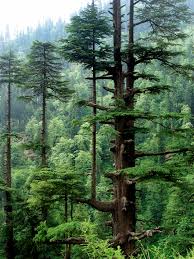Deodar
| Botanical Name: | Cedrus deodara |
|---|---|
| English Name: | Deodar |
| Local Name: | Sanskrit - Devadaru, Deodaru, Hindi - Deodar |
More Information
Unique identification feature
- The evergreen deodar cedar (Cedrus deodara), a true cedar, grows in the shape of a pyramid and has drooping branches with soft grayish-green or blue needles.It makes a graceful accent tree in the landscape and grows rapidly up to 20 to 30 feet wide and 40 to 50 feet tall.Tall, evergreen tree dark-green foliage, forming a typical conical crown. Branches two types, long shoots bear spirally arranged leaves, dwarf shoots bear cluster of leaves in pseudowhorls. The dwarf shoots elongate lightly, adding a new whorl of leaves each year. Flowers monoecious, male and female cones occurring on separate
Unique identification feature
- Deodar is widely regarded as one of the strongest woods in India and is as important as Teak. Timber is easy to saw. It is unsuitable for polish or print work as the oil in the wood (especially near the knots) always oozes through when exposed to direct sunlight and discolours the coating.It is easy to air-season but shows a little tendency to surface- cracking and end-splitting if dried too quickly, for this reason it should be air-seasoned under cover. It can also be kiln-seasoned easily without degrade. Seasoned heartwood of deodar is very durable and classified as durable class 1. The durability of deodar may be due to the presence of terpenes/resin acids present in the heartwood. Used primarily in buildings for beams, door and window frames and shutters and classified under group 1 timbers. Also used for furniture making and cabinet making to a limited extent. The thinning poles of deodar are suitable for overhead power and telecommunication lines. It is also used for making cases and donnage pallets. <!--[endif]-->Also found suitable for manufacture of high class pencils, cooling towers, drawing equipments, jute and textile mill accessories, wooden shingles, railway carriages, model and pattern making, keys of stairs etc.
Planting and Care
- To grow from seed, collect cones from deodar cedars before they turn brown. Soak them in warm water for two days to loosen the scales. Allow the cones to dry, then remove the seeds from the scales.The seeds have wings, which you should remove by rubbing them with a dry cloth. After you've processed the seeds, store them at 37 to 41 degrees Fahrenheit for two weeks. Sow the seeds 4 to 6 inches deep either in the spring or fall. If the seeds are dried to a moisture content of less than 10 percent and stored in a sealed container between 23 and 30 F, they will remain viable for three to six years. A must for cool gardens. Will tolerate high as well as low rainfall. Requires well drained soils.


